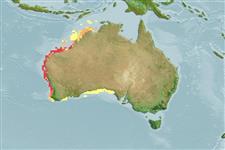Classification / Names
Common names | Synonyms | Catalog of Fishes (gen., sp.) | ITIS | CoL | WoRMS | Cloffa
Actinopterygii (ray-finned fishes) >
Pleuronectiformes (Flatfishes) >
Bothidae (Lefteye flounders)
Etymology: Engyprosopon: Greek, eggys = nearly + Greek,prosopon = a face (Ref. 45335); osculus: Named for its small mouth.
Environment / Climate / Range
Ecology
Marine; demersal; depth range 12 - 36 m (Ref. 27904). Tropical, preferred ?
Eastern Indian Ocean: Barrow Island, Shark Bay, and Rowley Shoal, Western Australia.
Size / Weight / Age
Maturity: Lm ? range ? - ? cm
Max length : 10.3 cm SL male/unsexed; (Ref. 27904); 9.2 cm SL (female)
Life cycle and mating behavior
Maturity | Reproduction | Spawning | Eggs | Fecundity | Larvae
Amaoka, K. and M. Arai, 1998. Redescription of a rare bothid, Asterorhombus bleekeri (Macleay), and description of a new species of Asterorhombus from northwestern Australia (Teleostei: Pleuronectiformes). Ichthyol. Res. 45(3):249-257. (Ref. 27904)
IUCN Red List Status (Ref. 115185)
CITES (Ref. 94142)
Not Evaluated
Threat to humans
Harmless
Human uses
More information
Common namesSynonymsMetabolismPredatorsEcotoxicologyReproductionMaturitySpawningFecundityEggsEgg development
Age/Size
Growth
Length-weight
Length-length
Length-frequencies
Morphometrics
Morphology
Larvae
Larval dynamics
Recruitment
Abundance
ReferencesAquacultureAquaculture profileStrainsGeneticsAllele frequenciesHeritabilityDiseasesProcessingMass conversion
Tools
Special reports
Download XML
Internet sources
